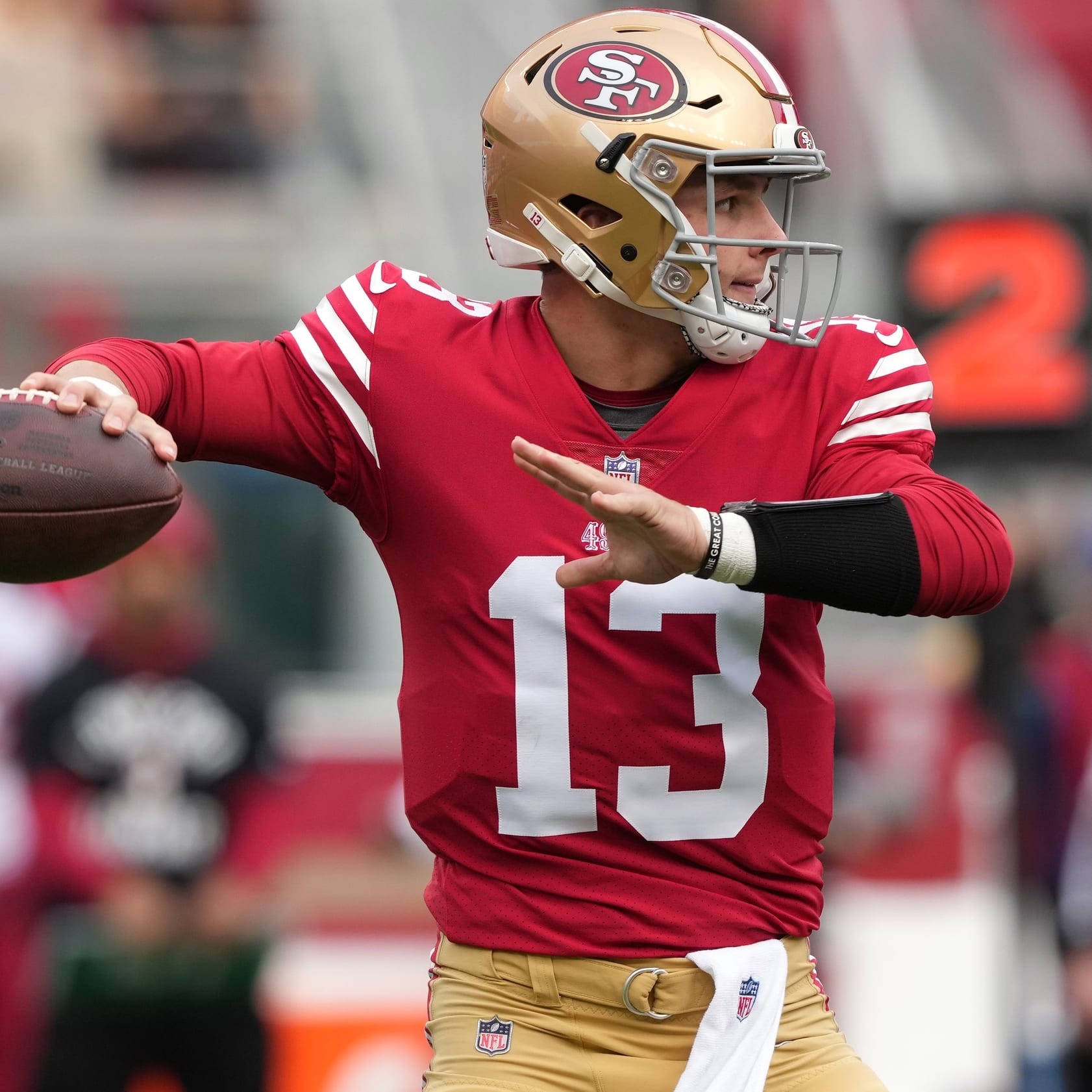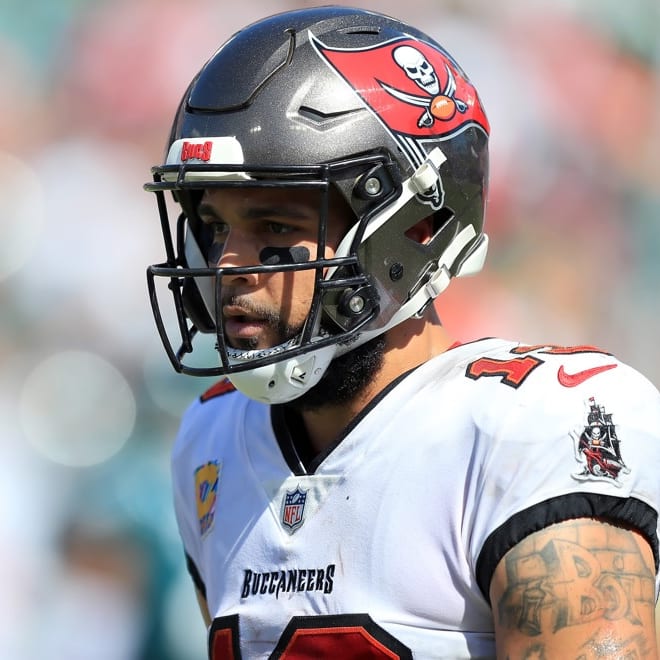This article is part of our Best Ball Strategy series.
The theme of last week's article was my despair at the devolving situations of Doug Baldwin, Rishard Matthews, Josh Doctson, and Jordan Matthews, but this entry will have a more general framing. These are five players I'm fading for now.
The players are listed in an ascending order of how much their ADP disgusts me. The MFL ADP cited is from the last three weeks.
Alshon Jeffery, WR, PHI (49.16 MFL)
I'm a big fan of Jeffery's talent, and I would eagerly buy at a certain point if his ADP fell, but the turn of the fourth and fifth rounds is a bit too early for my liking as he makes a return from offseason rotator cuff surgery. Jeffery is loosely expected to be ready for Week 1 but will miss most or all of training camp while recovering.
The Eagles have a deep group of pass-catching alternatives while Jeffery shakes off the rust, so they have no reason to rush his target count in the first few weeks. Zach Ertz, Nelson Agholor, and Mike Wallace can hold down that fort if necessary. Furthermore, Jeffery's timing with Carson Wentz was off last year, and depriving them of offseason work this year means they might take some time to get their rhythm down again this year.
If none of these things concern you, then consider Jeffery's durability issues even prior to this injury. There are no grounds to presume the best-case scenario in his
The theme of last week's article was my despair at the devolving situations of Doug Baldwin, Rishard Matthews, Josh Doctson, and Jordan Matthews, but this entry will have a more general framing. These are five players I'm fading for now.
The players are listed in an ascending order of how much their ADP disgusts me. The MFL ADP cited is from the last three weeks.
Alshon Jeffery, WR, PHI (49.16 MFL)
I'm a big fan of Jeffery's talent, and I would eagerly buy at a certain point if his ADP fell, but the turn of the fourth and fifth rounds is a bit too early for my liking as he makes a return from offseason rotator cuff surgery. Jeffery is loosely expected to be ready for Week 1 but will miss most or all of training camp while recovering.
The Eagles have a deep group of pass-catching alternatives while Jeffery shakes off the rust, so they have no reason to rush his target count in the first few weeks. Zach Ertz, Nelson Agholor, and Mike Wallace can hold down that fort if necessary. Furthermore, Jeffery's timing with Carson Wentz was off last year, and depriving them of offseason work this year means they might take some time to get their rhythm down again this year.
If none of these things concern you, then consider Jeffery's durability issues even prior to this injury. There are no grounds to presume the best-case scenario in his shoulder recovery, but even if you did, Jeffery's recurring leg injuries from 2015 and 2016 might be a source of worry.
It would be one thing to draft Jeffery at the turn of the fourth and fifth if the wide receiver market were inflated and the affordable alternatives were limited. This generally isn't the case. I think you can find similar floor and upside in players like Jarvis Landry (50.25 MFL), Corey Davis (64.38 MFL), Cooper Kupp (81.48 MFL), Jamison Crowder (82.68 MFL), and Marquise Goodwin (85.01 MFL).
Mark Ingram, RB, NO (41.04 MFL)
Ingram's inclusion here is kind of a variation on the same theme as Jeffery – a good player but one categorically limited by his circumstances. Players get hurt or have off weeks enough as it is, so why buy a player capped at 12 games in the fourth round of your draft?
Not only that, but I think we need to consider the possibility that Ingram doesn't fully regain his role upon return, at least not right away. Good as Ingram is, the Saints system likely makes him somewhat replaceable, and the guys fighting for his role in the first four weeks have legitimate talent. Payton might have every intention of putting Ingram back into his 2017 role upon his return, but guys like Trey Edmunds, Jonathan Williams, and Boston Scott are good enough to grow on Payton by then. Payton has a history of being somewhat impatient with Ingram, too. When Ingram (flukily) fumbled two games in a row in 2016, Payton gave 98 touches to Tim Hightower over the next five games.
Alex Collins (42.67 MFL) especially strikes me as a superior alternative. The guy has 119 carries and 31 targets in his last seven games, and he isn't suspended. I would probably prefer all of Jay Ajayi (43.99 MFL), Rashaad Penny (47.47 MFL), and Dion Lewis (52.44 MFL), too.
Chris Thompson, RB, WAS (76.13 MFL)
I was low on Thompson this year even before reports surfaced of him facing difficulty in his recovery from a broken leg suffered in November. When he commented recently about how this injury was more difficult for him than the fractured vertebrae and ACL tear he suffered previously at separate points, I was completely sure I'd own no shares this year.
First, my gripes with Thompson are not regarding his skill. Even back at Florida State he was a uniquely explosive player who was only hindered by injury. But those injuries are rather concerning ones, and Washington agreed to the point that they specifically envisioned him as a player limited to roughly 7.5 touches from scrimmage per game.
You may say, "But last year Thompson had 103 touches in 10 games! That's more than 10 touches per game! Do your homework before you talk, something something." I would say in response that Washington only upped Thompson's workload begrudgingly and out of desperation following the collapse of Washington's pass-catching rotation, precipitated by injuries suffered by Terrelle Pryor, Jamison Crowder, and Josh Doctson. That the offensive line was in ruin made Kirk Cousins that much more dependent on the checkdown.
Beyond that, Thompson's increased workload last year was also prompted by unsustainable production. He averaged 13.1 yards per catch and 9.4 yards per target after respectively posting 7.0 and 5.4 in those categories over the two years prior. Do you think Washington would have reluctantly increased his workload if they were tempted by the latter numbers instead of the former?
Whatever the specifics of how Thompson's fortunes play out this year, I can't fathom selecting him ahead of Duke Johnson (79.29 MFL), Marlon Mack (90.32 MFL), or even Giovani Bernard (115.29). Last year is gone.
Devin Funchess, WR, CAR (69.52 MFL)
Funchess generally goes ahead of at least six receivers I'd rather have: Emmanuel Sanders, Pierre Garcon, Cooper Kupper, Jamison Crowder, Marquise Goodwin, and Randall Cobb. I feel like it's relevant to mention that I have always been a leading advocate of Funchess, well before last year's breakout. I have no interest in seeing him disappoint his fantasy owners this year, because in a sense it'd make me wrong about my past statements.
Funchess finished last year with 840 yards and eight touchdowns on 111 targets (7.6 YPT), meaning his current ADP presupposes growth rather than stagnation or regression. The latter two are more likely. Funchess is a good prospect by my evaluation, but he began the process younger and more raw than most, and I'm not convinced that he's anywhere near his peak. If he's not near his peak, I expect fluctuation until then, especially since consistency has never been his strong suit.
More importantly, his break out only occurred in the context of Greg Olsen's foot injury and the Kelvin Benjamin trade. Even as an optimist for Funchess' career arc, 840 yards and eight touchdowns doesn't impress me if the WR2 is Russell Shepard. Do you think Funchess would have approached those numbers with all of Olsen, D.J. Moore, Torrey Smith, and Jarius Wright around, as they are this year? Not a chance.
Carlos Hyde, RB, CLE (71.68 MFL)
I don't think any player's ADP has ever puzzled me quite the way this one does. Something about the cumulative math behind the ADPs of Hyde, Duke Johnson (79.44 MFL), and Nick Chubb (85.8 MFL) is objectively wrong. If Hyde is worth the 72nd pick, then it can't be true that Johnson is worth the 79th and Chubb worth the 86th. At least one school of thought driving these outcomes is completely off the mark.
I'm open to debating which ones those are, but I'm inclined to single out the pro-Hyde momentum. I have no proof at all of this, but I would posit that the Hyde optimists are people who would generally concede that they are alienated or at least unnerved by rookies and work with a de facto deference to players they've already seen in an NFL uniform. Beyond this standard, there is no indicator that Hyde can match Chubb in any particular capacity. If not for a general undue favoritism toward veterans, all objective indicators point toward Chubb immediately establishing himself as Hyde's superior. Hyde will benefit from some amount of veteran deference, but it would take an injury to Chubb for Hyde to meet value even with this the case.
Hyde's ADP generally makes him the RB32. Players like Marshawn Lynch (82.81 MFL) and Isaiah Crowell (92.29 MFL) offer higher floors than Hyde, while players like Marlon Mack (90.32 MFL) and Aaron Jones (92.17 MFL) offer better ceilings. I would contend that Mack has a higher floor than Hyde, even.
Hyde (6-feet, 230 pounds) reportedly dealt with an injury when running a 4.66-second 40-yard dash at the combine, but even if healthy he wouldn't have approached the 4.52 Chubb ran at 5-foot-11, 227 pounds. When you look at their college production, this is another victory for Chubb. Chubb accumulated 4,769 yards (6.3 YPC) and 44 touchdowns on the ground in 47 games in the SEC, Hyde finished his Big Ten career with 3,198 yards (6.1 YPC) and 37 touchdowns in 41 games. That's with Chubb's numbers weighed down by a recovery year following a season-ending knee injury in 2015.
Where Hyde is particularly vulnerable to Chubb, though, is the pass catching variable. Chubb didn't do it much in college – how else was Georgia going to get Sony Michel on the field? – but he can definitely produce as a receiver. Hyde definitely can't. If you want to see what Chubb can do as a receiver, look at his freshman year Georgia tape when he replaced the injured Todd Gurley. Specifically look at his four-catch, 31-yard game against Missouri, and his five-catch, 59-yard game against Florida. Whatever you do, don't look at Hyde's receiving numbers in the NFL, at least not if you've eaten recently. His 152 targets resulted in just 109 receptions for 634 yards, a cursed 4.2 yards per target.










